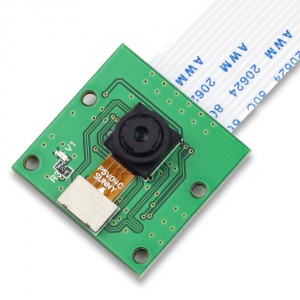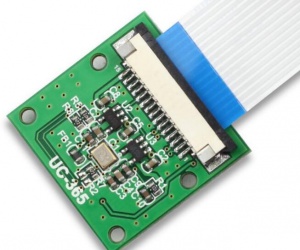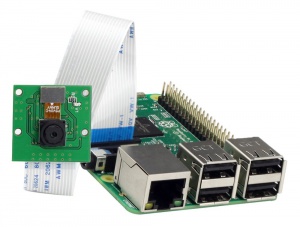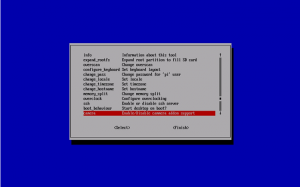ER-0011
RPI 5MP CSI Camera
Description
This camera can be support by RPi firmware, and the raspi-config tool has already support this camera.
It's an CSI standard camera and it can be hooked up to your Raspberry Pi.
Raspberry Pi use only.
Compatibility List
- Compatibility
| Platform | CSI camera | Notes |
|---|---|---|
| Raspberry Pi 4 Model B | √ | |
| Raspberry Pi 3 Model B Plus | √ | |
| Raspberry Pi zero | √ | |
| Raspberry Pi zero W | √ | |
| Raspberry Pi 3 Model B | √ | |
| Raspberry Pi 2 Model B | √ | |
| Raspberry Pi Model B+ | √ | |
| Raspberry Pi Model A+ | √ | |
| Raspberry Pi Model A | √ |
Features
| Parameters | Values |
|---|---|
| Camera lens : | 1/4 5M |
| aperture | 2.9 |
| focal length | 3.29 |
| Viewing angle | 72.4 degree |
| Weight: | 0.015 kg |
Package include
- 1 x RPI 5MP CSI Camera
- 1 x Flexible cable wire
How to wire it up
- Using Flexible cable, 90 degree vertical connector, next to the HDMI port. Connect to one side of the HDMI interface ( CSI port).
- Remove the protective film on the lens before use
- Bare board, pay attention to ESD damage, beware of static electricity!
How to use it
- RPi firmware and raspi-config has been updated for this camera.
- We assume that your Raspberry Pi had a TF card with an Raspbian OS in it and your Raspberry Pi has connected to internet.
- Please open a terminal and execute this command before you using it:
sudo apt-get install update
sudo apt-get upgrade
sudo raspi-config
Navigate to “camera” and select “enable”.and then reboot your Raspberry Pi.
Then, you can capture the picture and video by using this two command:
- Take a picture:
raspistill -t 5000 -o test.jpg
- Capture a video:
raspivid -t 10000 -o myvideo.H264
- You can use mplayer or oxmplayer to play this kind of video:
oxmplayer -o local myvideo.H264
How to send the data which is captured by camera
You can use nc command (ncat - concatenate and redirect sockets) to redirect the data to the network socket which captured by camera.
How to use the Raspberry Pi camera software
raspivid is a command line application that allows you to capture video with the camera module, while the application raspistill allows you to capture images.
- -o or –output specifies the output filename and -t or –timeout specifies the amount of time that the preview will be displayed in milliseconds.
Note that this set to 5s by default and that raspistill will capture the final frame of the preview period.
- -d or –demo runs the demo mode that will cycle through the various image effects that are available.
Example commands
- Capture an image in jpeg format:
raspistill -o image.jpg
- Capture a 5s video in h264 format:
raspivid -o video.h264
- Capture a 10s video:
raspivid -o video.h264 -t 10000
- Capture a 10s video in demo mode:
raspivid -o video.h264 -t 10000 -d
- To see a list of possible options for running raspivid or raspistill, you can run:
raspivid | less
raspistill | less
Use the arrow keys to scroll and type q to exit.
- Extended documentation is available.
Note that we recommend that you change SSH password if you are using a camera, in order to prevent unwanted access.
How to stream video from the Raspberry Pi camera over a network
- To view the feed on Linux
Install the dependencies by running the following in a terminal:
sudo apt-get install mplayer netcat
Find your IP address by running ifconfig. (Your IP address will be listed in the console output and will probably be of the form 192.168.1.XXX).
Run the following command in a terminal to view the feed using MPlayer:
nc -l -p 5001 | mplayer -fps 31 -cache 1024 -
- To view the feed on Windows
Install and run Linux instead.
Find your IP address by running ipconfig. (Your IP address will be listed in the console output and will probably be of the form 192.168.1.XXX).
Download MPlayer.
Download Netcat.
Note that your browser may complain that these files are malicious, as they are unsigned executables.
Press the Windows key and the ‘r’ key simultaneously to bring up the “Run” dialog. Enter cmd.exe into the dialog and press enter/return to open a DOS prompt.
Enter the following command at the prompt to view the feed using MPlayer:
[Path to nc.exe]\nc.exe -L -p 5001 | [Path to mplayer.exe]\mplayer.exe -fps 31 -cache 1024 -
- To view the feed on OS X
Download MPlayer.
Alternatively, you can download mplayer using Brew, which we recommend.
Find your IP address by running ifconfig. (Your IP address will be listed in the console output and will probably be of the form 192.168.1.XXX).
Run the following command in Terminal to view the feed using MPlayer:
nc -l -p 5001 | mplayer -fps 31 -cache 1024 -
- To view the feed on a Raspberry Pi:
Find your IP address by running ifconfig. (Your IP address will be listed in the console output and will probably be of the form 192.168.1.XXX).
Run the following commands in a terminal on the receiving Pi:
mkfifo buffer
nc -p 5001 -l > buffer | /opt/vc/src/hello_pi/hello_video/hello_video.bin buffer
- To transmit the feed from the Pi with camera module attached.
After setting up the “receiving” machine as per the instructions above, run the following commands in a terminal on the “transmitting” Pi:
raspivid -t 999999 -o – | nc [insert the IP address of the client] 5001
You can then use the commands listed in the “How to use the Raspberry Pi camera software” section above to change the capture time or to add a video effect.



